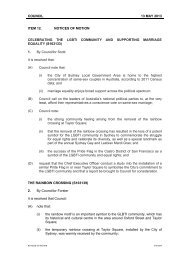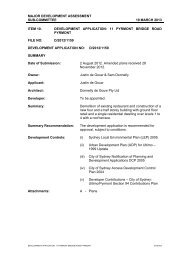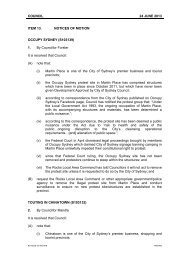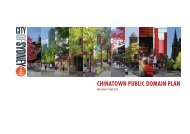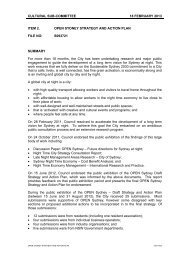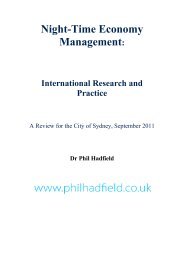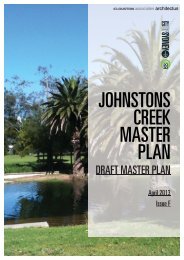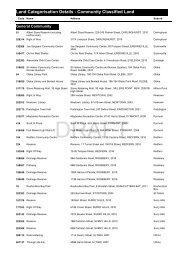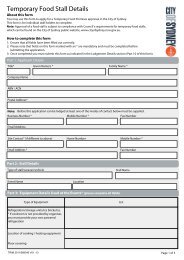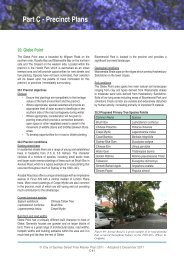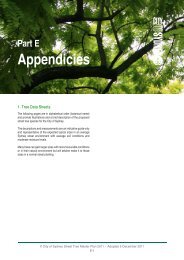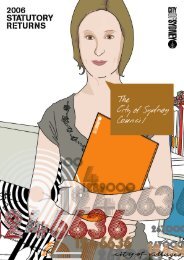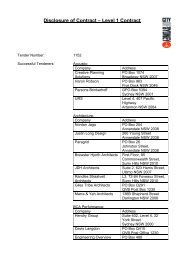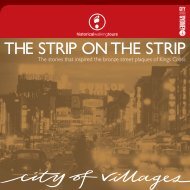Histories of Green Square - City of Sydney
Histories of Green Square - City of Sydney
Histories of Green Square - City of Sydney
Create successful ePaper yourself
Turn your PDF publications into a flip-book with our unique Google optimized e-Paper software.
Chapter 2 – Snapshots: <strong>Green</strong> <strong>Square</strong> <strong>Histories</strong> in Brief<br />
Chapter 2 Snapshots:<br />
<strong>Green</strong> <strong>Square</strong><br />
<strong>Histories</strong> in Brief<br />
2.1 The Pre-European Environmental<br />
Landscape in <strong>Green</strong> <strong>Square</strong><br />
Jason Doran<br />
The present-day appearance <strong>of</strong> the <strong>Green</strong> <strong>Square</strong> area hides<br />
an environmental history that is worth remembering and<br />
more importantly, worth restoring, in part at least. This area<br />
forms part <strong>of</strong> a unique environmental landscape known as the<br />
Botany Basin. Its story is one <strong>of</strong> adaptation to unusual environmental<br />
factors, and what emerged was a richly diverse,<br />
topographically distinct environmental landscape.<br />
<strong>Green</strong> <strong>Square</strong> was once covered in wetlands, dunes and dense<br />
shrubland, grading into low open woodland and forests. Its<br />
environmental history began more that 200 million years ago<br />
when the massive sandstone that underlies much <strong>of</strong> <strong>Sydney</strong><br />
was formed. Over the past 1.8 million years, windblown sand<br />
covered the Botany Basin, creating a vast dune system. But the<br />
element which came to characterise the area most was water: it<br />
ran southwards from the higher parts, pooling in lower places<br />
in the Basin, creating a network <strong>of</strong> swamps, pools and creeks<br />
which in turn flowed into Botany Bay.<br />
Water, sands, rocks and climate shaped the flora and fauna<br />
which flourished here: sedges, reeds and paperbarks in the<br />
swamps, grass trees, banksias, crimson bottlebrush and the<br />
spectacular Gymea lily in the scrub. The Botany Basin was<br />
home to the now endangered Eastern Suburbs Banksia Scrub<br />
vegetation community, remnants <strong>of</strong> which remain in isolated<br />
or protected locations. Nearer Centennial Park stood a dark<br />
and dense forest <strong>of</strong> ‘immense mahogany trees, blackbutt and<br />
other eucalypts’ as well as large cabbage-tree palms. Animals,<br />
reptiles, insects and birds in particular thrived in the wetland<br />
environment.<br />
This natural landscape was not only important for its own<br />
sake, it had cultural significance as well. Aboriginal people,<br />
the Eora, lived in and around <strong>Green</strong> <strong>Square</strong> for thousands <strong>of</strong><br />
years, hunting, fishing and foraging and creating social and<br />
cultural systems inseparable from country. After 1788 some<br />
Europeans were repelled by the area—considering it inaccessible,<br />
uninviting and ‘useless’—but others foraged and hunted<br />
here for food. It wasn’t until the late twentieth century that<br />
wetlands and their immense biodiversity began to be appreciated<br />
in the community generally, and acquire the cultural<br />
significance they now hold. By that time, a century and a half<br />
<strong>of</strong> industrial exploitation, drainage and infilling <strong>of</strong> swamps,<br />
building development and roads had long destroyed most <strong>of</strong><br />
the pre-1788 environmental landscape in <strong>Green</strong> <strong>Square</strong> and<br />
the wider region.<br />
However, remnant vegetation has survived in places, which,<br />
together with written records, can help us determine the<br />
biosphere that once existed in this area. This environmental<br />
history is essential in planning strategies for the future preservation<br />
and restoration <strong>of</strong> the region’s unique environment.<br />
2.2 Chimneys and Change:<br />
Post-European environmental impacts in <strong>Green</strong> <strong>Square</strong><br />
Scott Cumming<br />
The <strong>Green</strong> <strong>Square</strong> area is part <strong>of</strong> the larger environment <strong>of</strong> the<br />
South <strong>Sydney</strong> wetland corridor. This factor has been very significant<br />
in influencing post-European use <strong>of</strong> the area. From as<br />
early as the 1810s, local capitalists searching for power sources<br />
for their mills turned to the Waterloo/Botany area. Its relatively<br />
reliable water flow provided steam power for grinding<br />
grain and milling cloth.<br />
The area was also used as a source <strong>of</strong> water for the growing<br />
city. The pure water was diverted into tunnels and dams, and<br />
a pumping station was built on Lords Dam, which had been<br />
built for one <strong>of</strong> the early mills. The diversion and pumping,<br />
however, resulted in the drainage <strong>of</strong> the wetlands, as did<br />
further draining work to provide land for market gardens. By<br />
1869, the environment had changed radically: streams had<br />
almost ceased to flow, the swamps and their diverse plants and<br />
teeming wildlife were gone, and the area had become a ‘tract<br />
<strong>of</strong> barren sandhills’.<br />
The natural run-<strong>of</strong>f system from Waterloo Swamp to Shea’s<br />
Creek, the Cooks River and Botany Bay was admirably suited<br />
the purposes <strong>of</strong> industry: it was simply treated as an industrial<br />
waste drain. These waterways were soon polluted by foul water,<br />
refuse and ‘thick slimy matter’ from woolwashes, tanneries,<br />
boiling down establishments and abattoirs, and later from<br />
sawmills, foundries, soap and candle works and many more.<br />
The area was also used as a waste drain for sewage. From 1882<br />
to 1916 the southern outfall sewer system carried the southern<br />
suburbs’ human waste from Surry Hills to a sewerage farm on<br />
the northern bank <strong>of</strong> the mouth <strong>of</strong> the Cooks River. Part <strong>of</strong><br />
this system was an uncovered channel.<br />
13



